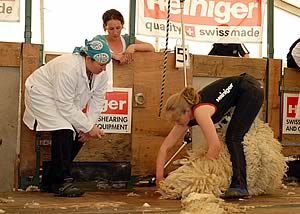2010-05-24
With the Northumberland County Show only a week away preparations for the sheep shearing competition are well advanced. Many visitors mistakenly regard the shearing as one of the ‘attractions’ and just a display of skill and dexterity but this is a hard fought and serious competition which just happens to be a bit of a spectacle.
Natalie Crisp shears under the watchful eye of judge Una Cameron with Joy Armstrong watching from the pen. All the young women are competitive shearers.
 |
Also mistakenly it’s regarded as a male dominated skill....not so. Women have always been accomplished shearers and this year it’s likely that Natalie Crisp from North Yorkshire, an intermediate shearer, and Una Cameron from the Borders an open shearer, will be competing alongside the men on equal terms. Its accepted that women shearers don’t have the physical strength of some men so may have to shear slightly differently but it’s not unusual to compete against men: Una Cameron competed at The Golden Shearers alongside male competitors earlier this year and made it into the top 30 open finalists....
“I first went on a British Wool Board Training course when I was 14” says Natalie Crisp “and have shorn each year ever since but have never shorn full time. I enjoy the challenge of the job and the satisfaction of finishing a day’s work to a high standard. Shearing has enabled me to work in New Zealand and Sweden. This has helped improve my skill further and given a wider variety of sheep to shear. The English circuit also allows you to shear different breeds within your own country at a competitive level.
Chris Chomse, Chief Steward of the Shearing Section and Vice Chairman of the show committee has seen the shearing section become one of the most popular attractions, always drawing large enthusiastic crowds as the Junior, Intermediate, Senior and Open classes battle away to be crowned champion. Some of the best local shearers, male and female, will be there this year as well as entrants from Scotland, Wales and New Zealand. “To win the coveted Open trophy sounds simple enough, all you have to do is clip the wool from 5 mule hoggs in the heats, 8 in the semi final and 15 in the final in the shortest time on the day. But like most things in life the reality is anything but simple. It’s a back breaking test of speed and skill” he says “The clipping takes place under the scrutiny of beady eyed judges who will mark a competitor down for a poorly finished fleece or a sheep with too many nicks and cuts. The event can only take place because of the 30 or so volunteers who work hard to set up and run this popular part of the show. We rely upon the generosity and goodwill of farmers who volunteer their time and the use of their livestock to make the shearing the fascinating spectacle that it is.”
In Northumberland we are used to seeing freshly shorn sheep appearing in fields as the summer wears on but there is a fascinating contrast between the UK and the rest of the world. Sheep have to be sheared at least once every 12 months as a part of animal welfare regulations and there has always been reliance upon some Kiwi and Australian labour coming into the UK to help out the local shearers. This year, due to stricter regulations on work permits there is a chance that there will be fewer of these summer visitors so 2010 may well be the year of the Great Shearer Shortage. That migration of labour has worked both ways and naturally enough as a shearing contractor Chris worked in both Australia and New Zealand. ‘The scale of sheep rearing in those countries is truly huge, flocks of over 20,000 sheep on stations of 50,000 acres are not uncommon and clipping 200 of those big Merino sheep a day really takes it out of you’.
He also worked for many years in Norway which was on a whole different scale. ‘The Norwegians bring their sheep from what tend to be small, remote farms down to the abattoir where they will be sheared prior to slaughter.’ The small scale of the farming was something that he saw as a great contrast to the super size Antipodean outfits. ‘Very often the whole family would come down with the sheep to see them on their way and make sure they were well looked after. When you only have 30 sheep you tend to know each one individually’.
The shearing section of the Northumberland County Show goes back to the 1980’s when Simon Gregory gave the first shearing demonstration. Although retired from contracting, Simon now runs shearing courses at Kirkley Hall and he spent years travelling the ‘circuit’ and sheared sheep in many countries including Norway, Belgium and Corsica. ‘Corsica was very interesting’ said Simon ‘They farmed in a very traditional way and there the large flocks of milk sheep would be sheared for hygiene reason alone, the poor quality wool was simply burned or dumped in a river.’ Simon went on ‘There was also the unusual sight, to English eyes, of a priest dipping a lock of wool in water and blessing the newly shorn sheep in the hope of multiple lambs and high milk yields.’
 Waiting List for Livestock as Three Counties Show Thrives Waiting List for Livestock as Three Counties Show Thrives
 Skills Training Courses for Beef Farmers Skills Training Courses for Beef Farmers
 British Pig and Poultry Fair Debate Votes for Buy British Campaign British Pig and Poultry Fair Debate Votes for Buy British Campaign

|




